0 Nomenclature

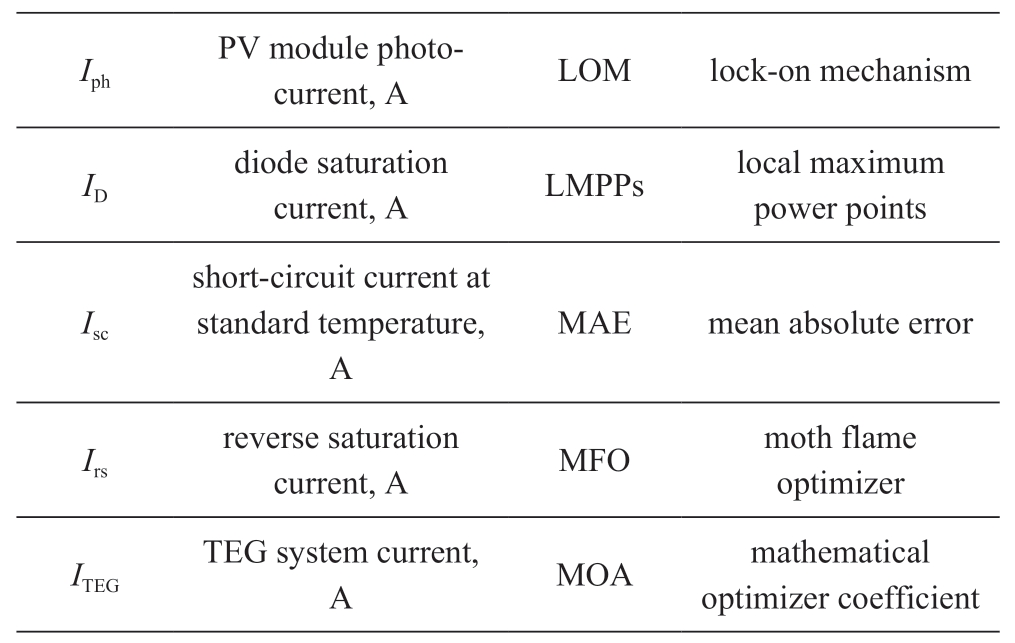
continue

1 Introduction
1.1 Background
The surge in demand for energy production and supply owing to economic development,rapid depletion of traditional energy sources,and environmental deterioration has prompted the exploitation of environmentally friendly renewable energy sources [1-5].In recent years,the application of renewable energy to cope with climate change and promote energy reform has become a concerted effort of the international community [6,7].Of the currently available renewable energy sources,solar energy is one of the most mature and widely applied,and has the significant advantages of being clean,safe,and sustainable [8-10].
Photovoltaic (PV) cells are an effective means of generating electricity from solar energy,but their energy conversion efficiency is relatively low [11-13].Notably,most of the solar energy captured by the PV cells dissipates in the form of heat,which increases energy loss and leads to an increase in the temperature of PV panels.This temperature increase not only reduces the energy conversion efficiency of solar cells,but may also negatively affect their electrical parameters and service life [14,15].In addition,external environmental factors such as dust,rain,and snow adversely affect the performance of PV panels [16,17].An effective solution for reducing the temperature of PV cells and harvesting the waste heat generated by PV systems[18-21],is to combine PV modules with athermoelectric generators (TEGs) to form hybrid PV-TEG systems [22-29].
A hybrid PV-TEG system usually includes PV modules,TEGs,and a cooling system [30-32],where PV arrays are mounted on the upper surface of the TEG as the hot side,and the heat sink is arranged on the other surface of the TEG as the cold side.Thus,a reasonable temperature between the cold and hot sides of the TEG can be maintained to achieve a higher energy conversion efficiency [33-37].PV modules mainly absorb ultraviolet (UV) and visible light,whereas TEGs absorb the rest of the radiation spectrum and convert part of the waste heat generated by the PV into electricity.Finally,the remaining waste heat is transmitted to the heat sink by the TEGs [38,39].The PV-TEG hybrid system usually has two maximum power point tracking (MPPT)controllers and booster circuits to aggregate the power obtained from the two arrays.Figure 1 shows a topology diagram of such a hybrid system.
Currently,researchers have mainly focused on absorption density [40],spectrum splitting [41],material design [42-45],and structural modification [46-48] to optimize the performance of hybrid systems.Notably,several studies [49-54] have verified the feasibility of combining PV with TEG systems.In reference [55],a new collector of parabolic trough PV/thermal energy was proposed and compared with standard operating conditions,showing that the power generation of the PV system was quadrupled.Furthermore,[56] adopted microchannel heat pipe arrays to form a novel PV-TE-MCHP system,which achieved an electrical efficiency of > 14.0% while reducing the costs of the conventional hybrid system.Subsequently,reference [57] connected a low-concentration light/thermal(LCPV/T) collector in series with a TEG to convert electricity from low to high grade,which,with further improvement,has the potential to provide electricity at night.In addition,[58] reports the use of a nanofluid as a cooling medium in the heat sink of a hybrid system to improve heat dissipation and system power generation efficiency.Furthermore,references [59] and [60] comprehensively describe the feasibility,common types,materials,and optimization of PV-TEG hybrid systems.Table 1 lists the performance and other key characteristics of some current studies on the optimization of PV-TEG systems.
Table 1 Chronological review of current PV-TEG research
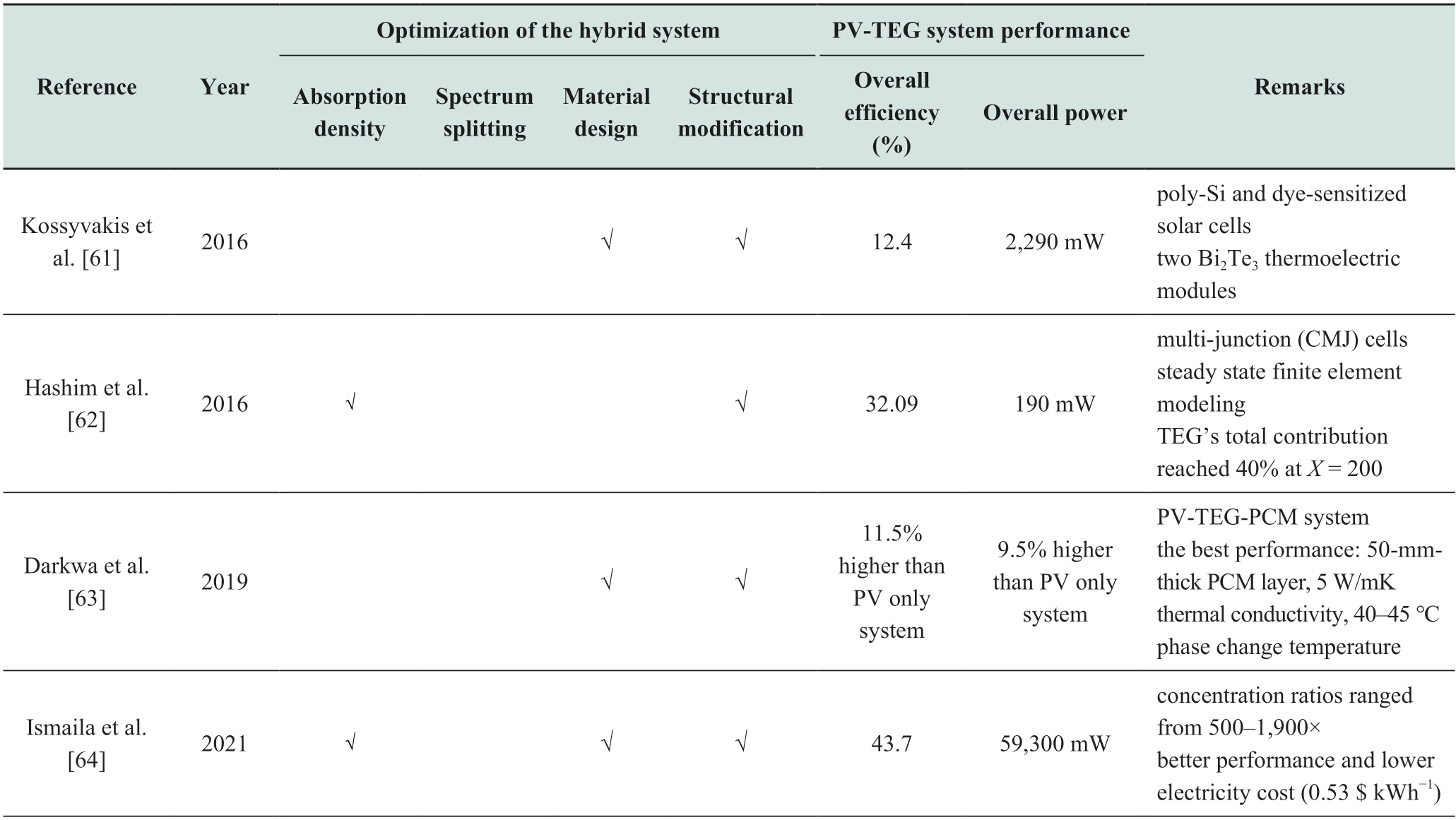
continue
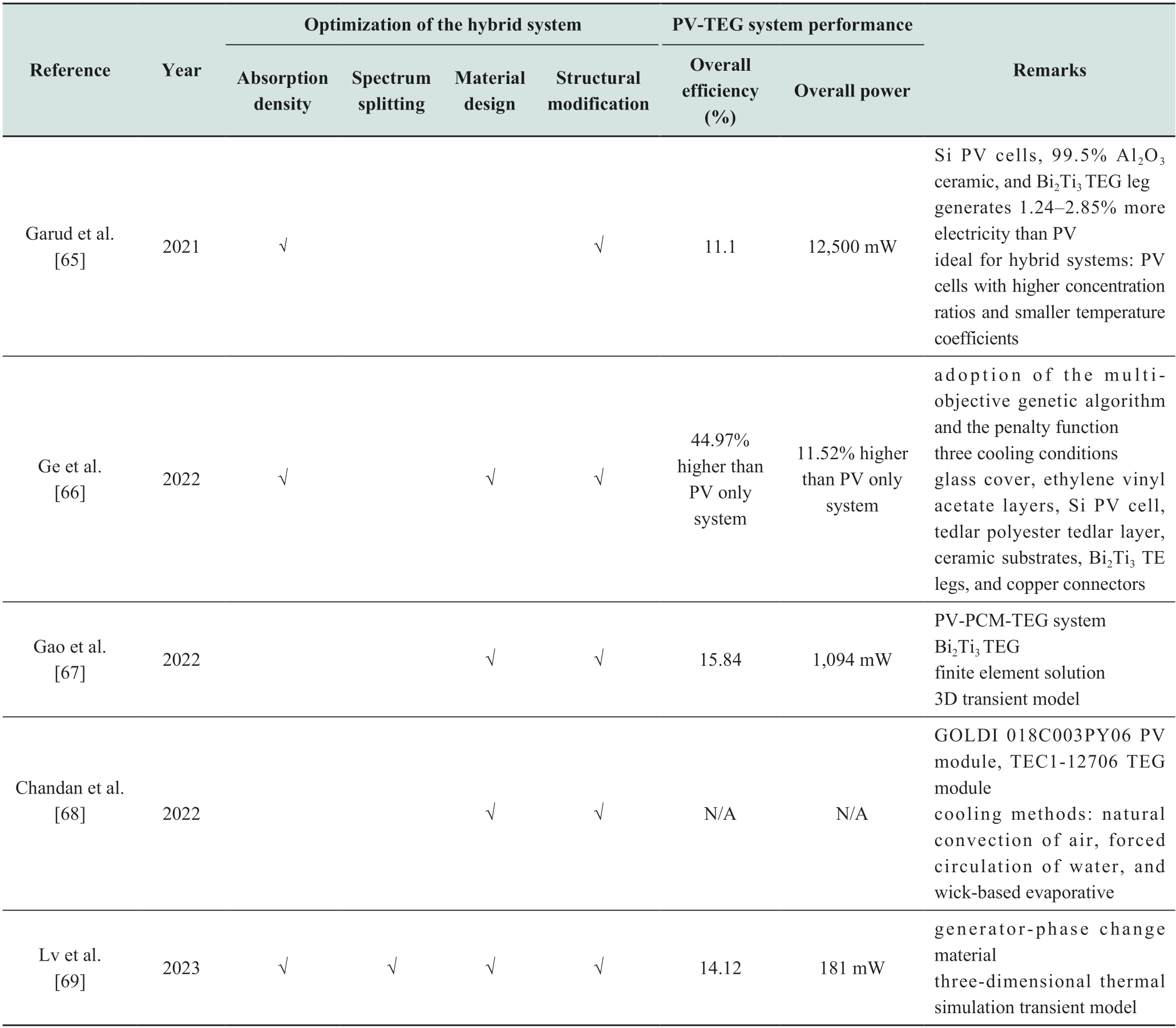
In addition,MPPT control techniques play an essential role in improving the power conversion efficiency of hybrid renewable energy systems,because it is crucial for hybrid systems to efficiently and precisely modify the operation point to maximize the collected power under changing operating conditions,particularly when multiple local maximum power points (LMPPs) appear under partial shading conditions (PSC).To date,a series of MPPT algorithms has been developed for PV and TEG applications.For instance,conventional algorithms,such as the incremental conductance (INC) [70] and perturb and observe (P&O) methods [71],can obtain satisfactory MPPT performance under homogeneous operating conditions,which can act as the design basis for other new algorithms.Not only is it difficult for conventional algorithms to find the global maximum power point (GMPP) quickly in the case of non-uniform temperature due to PSC,but it also easily falls into a local optimum,meaning that metaheuristic algorithms are introduced.Compared to conventional algorithms,metaheuristic algorithms have a more powerful global searching capability under nonuniform temperature distribution (NTD) conditions and PSC,including,for example,particle swarm optimization(PSO) [72,73] and the whale optimization algorithm(WOA) [74].Moreover,artificial intelligence (AI)algorithms,such as artificial neural network (ANN) [75]and fuzzy logic control (FLC) algorithms [76,77],are more suitable than traditional algorithms for tracking the GMPP in NTD and PSC.A comprehensive summary of sixty-two MPPT algorithms for PV systems was presented in [78],in which various MPPT methods were systematically introduced and compared.
1.2 Research purpose and main contributions
In view of the aforementioned reviews,existing studies tend focus more on the MPPT of PV systems and the improvement of hybrid systems in terms of structure and materials,whereas there are few in-depth studies on MPPT algorithms for hybrid PV-TEG systems.Thus,the main purpose of this study is to provide a systematic summary and comparison of existing studies and identify prospects for future work on the MPPT algorithm design for hybrid PV-TEG systems.
The main contributions/innovations of this review can be summarized as follows:
(1) Fourteen MPPT algorithms were classified into five major categories—traditional,mathematics-based,metaheuristic,artificial intelligence,and other.Thus,this review presents a systematic classification of different MPPT algorithms for hybrid PV-TEG systems and discusses a wide variety of algorithms for each subclass.
(2) Several novel MPPT methods,such as the atomic orbital search optimization (AOS) algorithm and the arithmetic optimization algorithm (AOA),are discussed in detail to evaluate their performance and demonstrable superiority,with the aim of inspiring further exploitation of these new powerful strategies in related fields.
(3) Different MPPT algorithms applied to hybrid PVTEG systems are systematically summarized and compared according to a range of criteria in terms of the types of PV and TEG systems,solar irradiance,complexity,tracking capability,and economics involved.
(4) Based on a comprehensive investigation of previous studies,perspectives on the future research and development of MPPT algorithms for hybrid PV-TEG systems are presented.
The remainder of this paper is organized as follows:Section 2 presents the mathematical modeling of the hybrid PV-TEG system and briefly describes the PV arrays under partial shading conditions (PSC); Sections 3-7 provide a detailed classification and summary of various MPPT algorithms for hybrid PV-TEG systems; a discussion and conclusions are presented in Section 8; and,finally,some perspectives are summarized in Section 9.The overall structure of this work is shown in Fig.2.The relationships between the different chapters are also shown schematically in Fig.3.
1.3 Review screening methods
In recent years,a large variety of MPPT techniques have been proposed for hybrid PV-TEG systems; therefore,related references (for works written in English) were first investigated based on keywords including “photovoltaic”,“thermoelectric generato”,“hybrid system”,and “maximum power tracking” using three representative databases(Science Direct,Web of Science,and Google Scholar).We also used two databases (China National Knowledge Internet and Baidu Academic) to search for Chinese literature.A second-round selection was then conducted according to article title,abstract,and keywords.Finally,135 references were screened based on citations,journal impact factors,and general quality.The overall process of the literature review screening is illustrated in Fig.4(a).In addition,Fig.4(b) shows the publication trends in this field over the last ten years (from 2012 to November 2022).
2 Mathematical modeling of hybrid PV-TEG systems
A hybrid PV-TEG system generally includes a PV module,TEG,and cooling system [79],in which the PV system plays the main role.Mathematical models of a PV systems are typically single-diode models (SDMs).According to Kirchhoff’s current law (KCL) [80],the current relationship of a SDM-based PV cell can be represented as:
where IPV is the output current of the PV cell,Iph is the incoming photon current,and ID is the diode saturation current.
Furthermore,Iph is calculated using Eq.(2),and ID can be expressed by Eq.(3) [81,82],thus:

where Isc is the short-circuit current at standard temperature,Ki is the current conductivity,T is the temperature,TSTC indicates the temperature under standard testing conditions(STC),G is the instantaneous irradiance,GSTC is the irradiance under STC,Ns is the PV cell number,and TSTC and GSTC are 298 K and 1,000 W/m2,respectively.
For the reverse saturation current,Irs in Eq.(3) can be expressed as follows:

where Irs is the reverse saturation current,Ist is the reverse saturation current at TSTC,Voc denotes the open-circuit voltage,q represents the charge on electron,k equals to 1.38 × 10-23 J,and A and Eg are the diode ideality factor and band gap energy,respectively.
Hence,Eq.(1) can be described as follows [83]:

where Rs is the series resistance and Rsh is the parallel resistance.
The power-generation efficiency of a PV module is calculated as follows [84,85]:
where PPV represents the output power and APV denotes the surface area of the exposed PV modules [86,87].
The generated power of a TEG module is calculated by:
where RTEG is the internal resistor and RL illustrates the loads resistance.
Qh denotes the heat flow rates of the TEG modules [88],and is defined as follows:
where N indicates the number of thermocouples,ITEG denotes the electric current flowing through TEG system,K is the thermal conductance,R represents the electrical resistance,and μ is the Thomson coefficient.
Finally,the power generation efficiency of a TEG module is calculated as follows:
Figure 5 illustrates the typical construction of a combined hybrid PV-TEG module,in which the PV arrays and TEG are connected either in parallel or in series [89].The series-connected PV cells and TEGs have the least number of power electronic switches,and,therefore,the least power loss.It can be seen that PV arrays are mounted on one surface of the TEG to represent the hot side; the heat sink is arranged on the other surface as the cold side.This ensures a reasonable level of temperature difference of the TEG to achieve a higher energy conversion efficiency.The TEG not only collects waste heat and reduces the temperature of the PV modules but also effectively improves the utilization efficiency of the solar spectrum.The overall energy conversion efficiency of the hybrid PVTEG system can be expressed as follows:
Generally,there are two main types of PV-TEG hybrid systems.The first does not have a reflector,with the PV modules and TEGs placed parallel to each other,as shown in Fig.5.PV modules primarily absorb ultraviolet and visible light,and infrared radiation is conveyed to heat the top side of the TEGs,thereby generating a temperature difference between the cold sides.The second type has a reflective component,as shown in Fig.6.This kind hybrid device places the PV modules and TEGs perpendicularly,and solar radiation is diverted by the reflector according to a cutoff wavelength [90],which is reflected in the TEG when the radiation is larger than the cutoff wavelength; otherwise,it arrives at the PV module.
The first installation type does not require a complex optical design and tracking,and the system structure is relatively simple.Furthermore,higher energy conversion can be achieved under scattered light and sunlight conditions with low light intensity.The second type has stricter requirements for sunlight conditions,and sufficient direct sunlight is required to achieve effective light-focusing.Therefore,the first type is widely used in the design and research of MPPT for hybrid systems [91],and most of the MPPT methods mentioned in this paper use this type.
To improve output voltage and power,PV cells are generally connected in series and parallel to form PV arrays.In practical applications,PV systems tend to be exposed to different irradiance intensities owing to shading conditions caused by trees,clouds,or buildings,which are called partial shading conditions (PSC).Under PSC,the shaded PV panels are equivalent to a load that consumes the energy produced by other PV panels under uniform irradiance intensity.In addition,shaded PV panels work like diodes under reverse voltage with a high voltage drop and resistance,consuming a great deal of power and generating waste heat,which results in a “hotspot effect”.Notably,severe hotspot effects can destroy entire PV modules,causing permanent damage [92].
To prevent hotspot damage to PV systems,bypass diodes are generally connected in reverse parallel to the PV battery [93,94],as shown in Fig.7.Bypass diode are in a reverse bias state under normal conditions and do not affect the normal operation of PV cells.However,when a PV module is shaded,a forward bias voltage is formed at both ends of the bypass diode and the diode conducts,thus limiting the current,effectively solving the problem of the hotspot effect,and avoiding shaded battery overheating damage.In general,the use of diodes can protect PV systems from the aforementioned hazard but inevitably leads to a change in the P-V characteristic curves of PV arrays; that is,multiple LMPPs appear instead of the ideal single GMPP,as shown in Fig.8.Therefore,an effective MPPT control technique is required to reliably modify the operating point to ensure that a system operates at the GMPP for maximum output power.
3 Conventional algorithms
3.1 Perturb and observe method
In reference [95],an improved perturb and observe(P&O) method with adaptive and variable step sizes for the MPPT control of hybrid PV-TEG systems was proposed,with which MPPT accuracy reached approximately 96% when applied to a PV system in a previous study [96].Figure 9 shows the detailed implementation process of this system,and Fig.10 shows a comparison between the variable- and fixed-step-based P&O methods.This work was mainly aimed at designing a new hybrid power supply that integrates a commercial PV module with seven TEG modules between a two-phase closed thermosiphon (TPCT)heat pipe and heat sink to efficiently collect solar radiation and heat.However,the adopted MPPT algorithm has not yet been thoroughly studied and discussed,including its convergence speed,comparison algorithms,and accuracy,after being applied to the hybrid system.

Fig.1 PV-TEG hybrid system topology diagram

Fig.2 Structure of this review

Fig.3 Relationships between the chapters in this review


Fig.4 Review screening methods of related references: (a) review screening procedure and (b) research trend statistics based on numbers of publications per year

Fig.5 Structure of a typical PV-TEG hybrid module
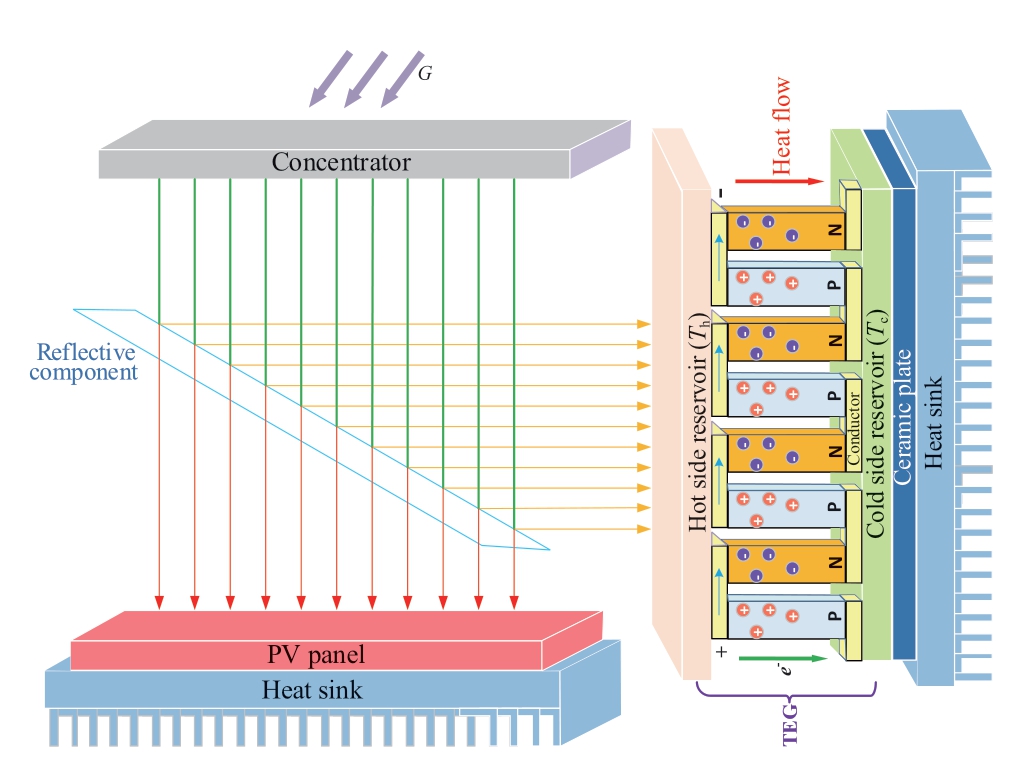
Fig.6 A PV-TEG device with a reflective component
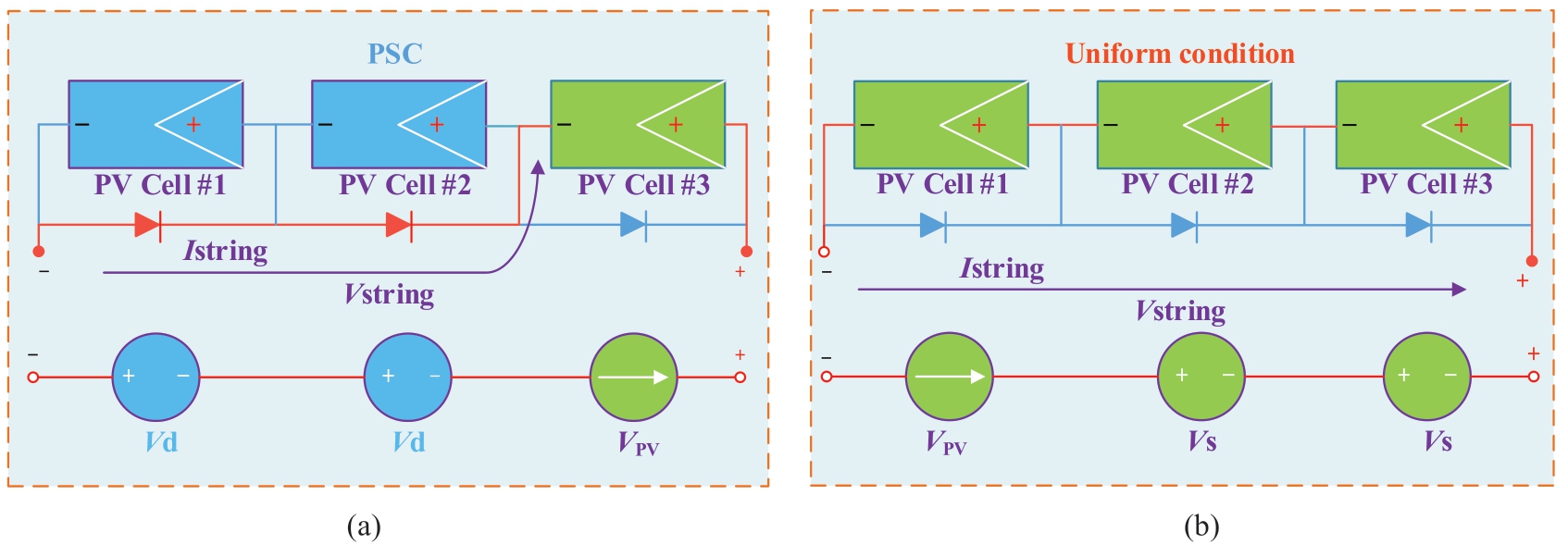
Fig.7 PV battery with bypass diode: (a) with PSC and (b) under uniform condition
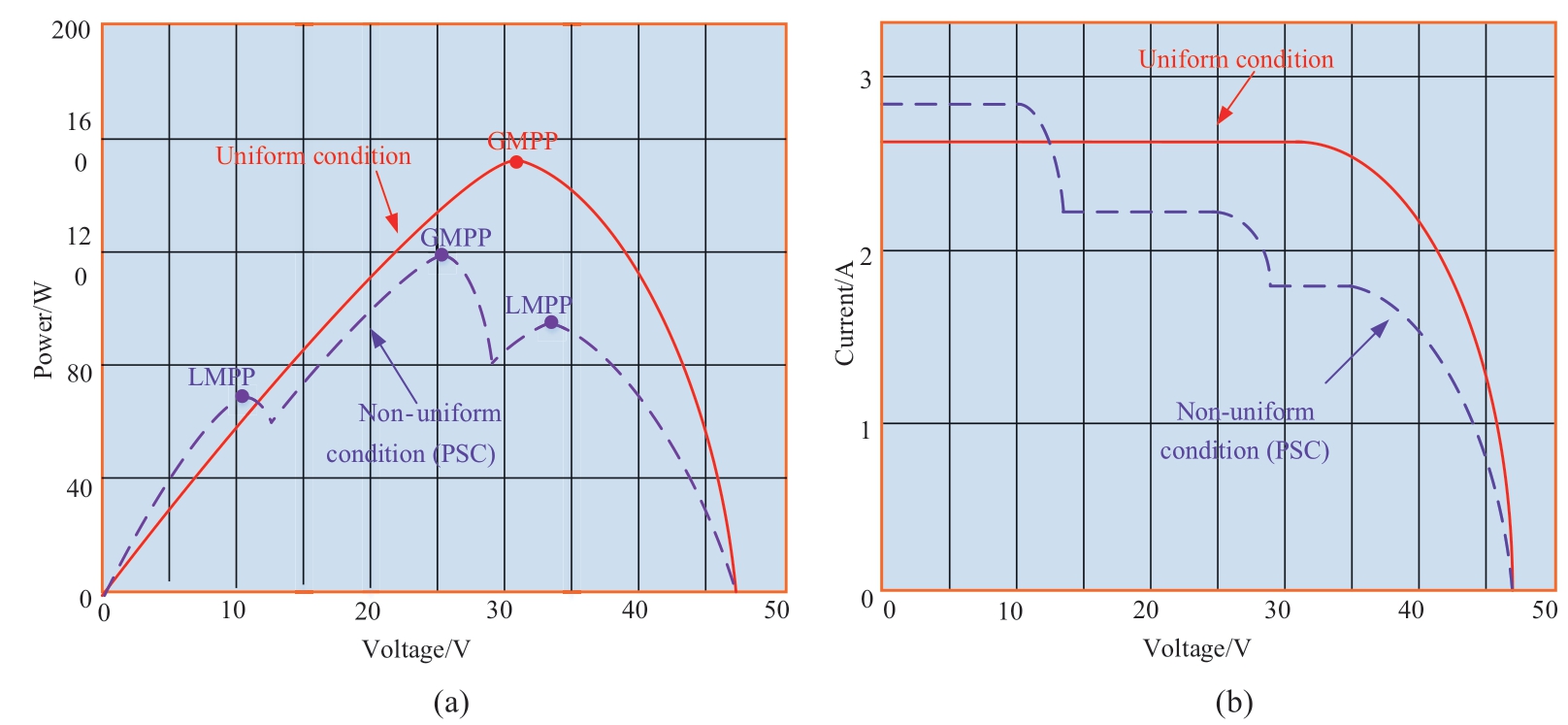
Fig.8 Comparison of output characteristic curves of PV arrays under PSC and uniform condition:(a) P-V curve and (b) P-I curve
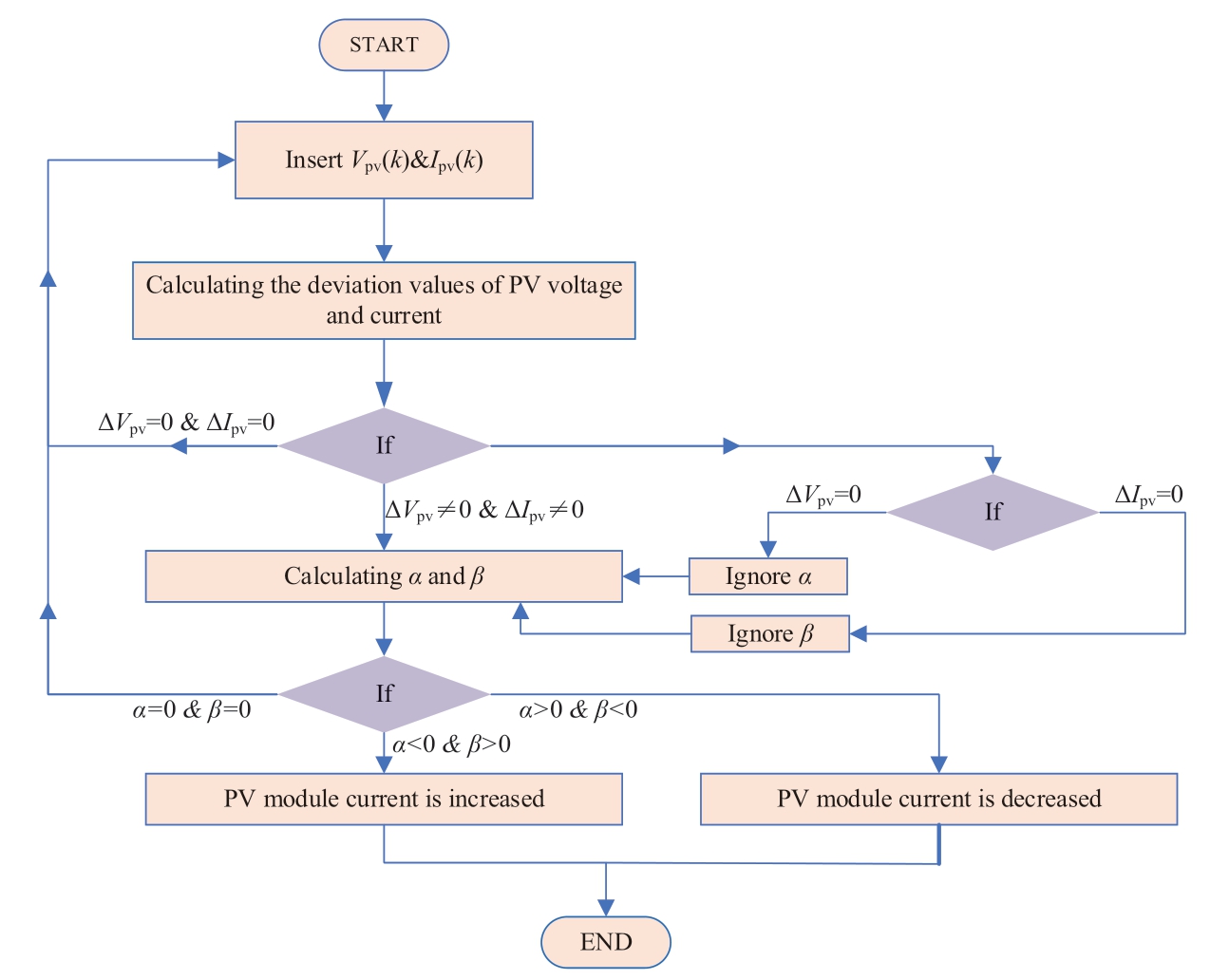
Fig.9 Implementation process of the P&O method

Fig.10 Comparison between P&O fixed and variable steps

Fig.11 Execution process of the INC method
3.2 Incremental conductance method
The hyperbolic tangent-type adaptive variable step length algorithm overcomes the weakness of the traditional INC method based on the monotonic incremental and speedy change of the hyperbolic tangent function,which allows the step length to be adaptively adjusted with the change in operating conditions,thereby realizing fast tracking of the MPP in PV-TEG hybrid systems [97].The hyperbolic tangent function is expressed as follows:
and the step size is adaptively adjusted by:
where ΔUmax represents the maximum step-size set obtained using the INC method.The maximum step size increases when the operating point of the system is located far from the MPP.Conversely,when the operating point is near the MPP,the step size will be quickly adjusted to decrease.Figure 11 shows the implementation process of this method [96].
Research results show that when light intensity and other external environmental conditions change dramatically,the activation time of a system is significantly decreased,and the MPP can be quickly tracked within 15 ms with a steadystate error < 0.3%.Moreover,the algorithm is characterized by its simplicity,low hardware power consumption,and high adaptability.However,this method may cause operating-point fluctuations,reduce system stability,and add computational complexity when applied to large-scale hybrid systems.Under these circumstances,the response speed is limited,and high hardware and software support are required,which further increases the cost of system implementation.
4 Mathematics-based algorithms
4.1 Power differential algorithm
The power differential maximum power tracking (PDMPPT) algorithm [98] controls the boost converter by comparing the output power of a system at the beginning and end of the power curve,keeping the load matched to the system.Thus,the MPP can be tracked without additional circuitry to measure short circuit currents and open circuit voltages,allowing the system to operate over a wide range of temperature differences.This study considered three different TEG configurations—a single TEG,and three TEGs in parallel and in series.When the temperature difference equals 100 ℃,the MPPT efficiency of a single TEG and three TEGs in parallel exceeds 97.7%.In addition,such a system applies a Kalman filter to smooth the disturbance.The Kalman gain (Kg) value is designed to be between 0 and 1,which can be expressed as follows:
where Eest represents the estimate error and Emea denotes the measurement error.
The PD-MPPT algorithm successfully tracks the MPP in the PV-TEG hybrid system when multiple MPPs emerge in the output power curve.Notably,the complexity and economic cost of the algorithm are relatively low,although its convergence speed requires further investigation,and its efficiency can be improved by shortening the examination period.
4.2 Fractional order proportional integral derivative algorithm
The MPPT control algorithm,based on the modified fractional-order proportional integral derivative (FOPID),adjusts the duty cycle according to the error signal,thus applying proper control action to adjust the system operating point closer to the peak of the supply voltage (P-V) curve to reach the MPP.A very low or zero error indicates that the system operating point has reached the MPP.The error signal can be expressed as follows [99]:

where P(t) and P(t-1) are the current and last instantaneous output power,respectively,and V(t) and V(t-1) represent the current and last instantaneous output voltages,respectively.
In addition,the algorithm dynamically updates the derivative m according to the voltage variation value to realize fast tracking capability,with μ ranging between 0.1 and 1.When the operating point of the hybrid system approaches the MPP,the voltage variation is 0 or very small,and μ is adjusted to 1 to ensure that the operating point of the system quickly moves to the MPP while reducing the impact of oscillations of the hybrid system to achieve a stable output.Under the same output voltage and power,P&O requires approximately 0.075 and 0.1 s to achieve the final steady-state voltage and power,respectively,while FOPID controllers only require 0.05 s to achieve this,with small convergence oscillations of output power.As a result,compared to the P&O method,FOPID has faster convergence,smaller oscillations,and stronger MPP tracking capability.However,this has only been compared against a traditional algorithm,meaning a more comprehensive comparison with more diverse algorithms is required to further validate its relative effectiveness.
5 Metaheuristic algorithms
5.1 Atomic orbital search optimization algorithm
In [100],an MPPT technique for hybrid PV-TEG systems based on the atomic orbital search optimization(AOS) algorithm was developed.The optimization principle of the AOS algorithm was inspired by the moving behavior of electrons in atoms,as shown in Fig.12.Figure 13 shows an optimization flowchart of the AOS algorithm.The atomic binding states and binding energies in the search phase of the AOS algorithm are determined by considering the positions of all candidate solutions and the average of the target function values in the search space,as follows:

Fig.12 A schematic diagram of the AOS principle: (a) the behavior of electrons in atoms and(b) PDF determines the distribution of the candidate solutions
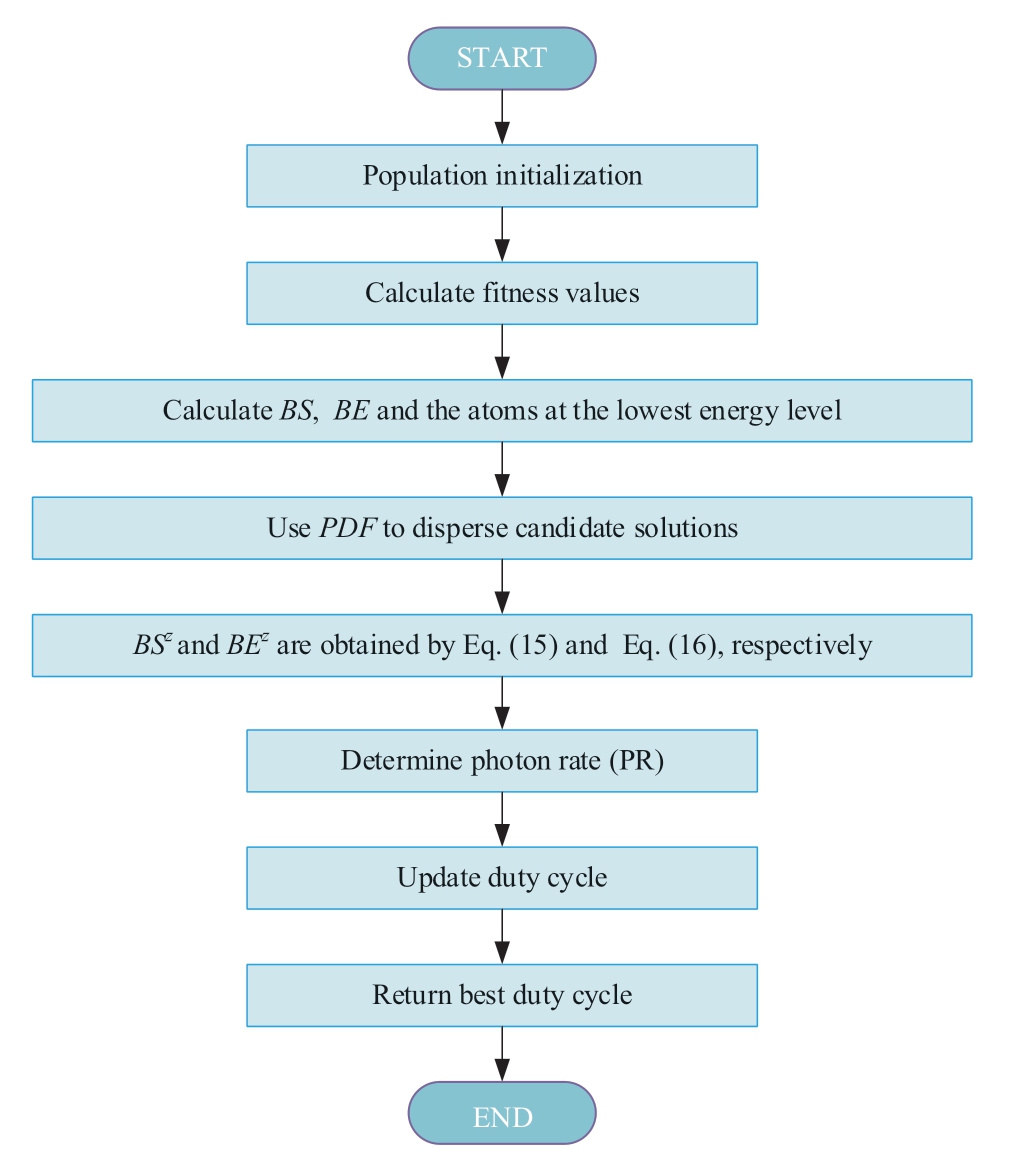
Fig.13 Optimization flowchart of AOS

where BSz denotes the state of the zth layer and BEz represents the binding energy; Aiz and Biz are the location and fitness values of candidate i in layer z,respectively; p is the number of layers; and k represents the total number of solution candidates [101].
The simulation results show that the AOS algorithm tracks the optimal power with the highest efficiency compared to the conventional P&O and other metaheuristic algorithms,reaching 99.987% (Table 2).It can be seen that the AOS algorithm not only reduces the tracking time but also enables more energy to be obtained with the minimum relative error (RE),mean absolute error (MAE),and rootmean-square error (RMSE) of all the algorithms.Because dynamic weights are adopted during the iterations,the GMPP can be quickly tracked while avoiding being trapped in LMPPs.In addition,the AOS algorithm-based controller can effectively decrease power loss when the hybrid system experiences frequent changes in temperature and solar radiation.
Table 2 Comparison of simulation results obtained by various algorithms

The algorithm also has some disadvantages.For instance,a more complex computation and larger computational cost are incurred for large-scale hybrid PV-TEG systems.In addition,because the AOS is more sensitive to the selection of initial solutions,these initial solutions must be carefully selected for a desirable optimization performance.
5.2 Arithmetic optimization algorithm
The arithmetic optimization algorithm (AOA) updates the individual position using arithmetic operators instead of calculating its derivatives,and has also been applied to the MPPT control of hybrid PV-TEG systems [102].The search and development phases of the AOA are mainly controlled by the mathematical optimizer coefficient (MOA) and mathematical optimization probability (MOP),respectively,as follows:

where Max and Min denote the maximal and minimum values of the MOA,respectively; iteri represents the current iteration; max_iteri is the maximal iteration number; and α is the sensitive parameter.Table 3 lists the distribution properties of the arithmetic operators in the AOA,and Fig.14 shows a schematic of the search phases of the AOA.Figure 15 shows a flowchart of the AOA-based MPPT for the hybrid PV-TEG system.
Table 3 Distributional properties of arithmetic operators


Fig.14 Searching phases of the AOA

Fig.15 Flowchart of the AOA-based MPPT within a PV-TEG system

Fig.16 Schematic diagram of the SQS-NN structure
AOA-based MPPT technology shows superior performance in terms of tracking accuracy,tracking efficiency,and voltage stabilization compared to the GWO,PSO,cuckoo search algorithm (CSA),and P&O algorithms.Notably,this technique can track the GMMP with up to 99.96% efficiency under a variety of nonstationary working conditions,and the average GMMP tracking time of the AOA is 180 ms,which is 65.8% higher than that of both the PSO and CSA.Nevertheless,the algorithm is a local search algorithm and may not be able to obtain a global optimal solution if the search space is large or if the problem has multiple local optimal solutions.Furthermore,AOA is not applicable to discrete problems.In a hybridPV-TEG system,some variables may be discrete,thus the performance of the AOA may be limited when dealing with these discrete variables.
5.3 Hybrid INC and moth-flame algorithm
A hybrid MPPT method applied to PV-TEG hybrid systems under various operating conditions combining the INC and moth flame optimizer (MFO) was discussed in [103].The hybrid INC-MFO algorithm combines the advantages of both algorithms,in which the INC algorithm is mainly used to track the MPP in the case of a uniform solar irradiance distribution to provide fast tracking ability.Meanwhile,the MFO is utilized in the case of the PSC to achieve the best MPP with high accuracy,in which the positions of the moths are updated as follows:
where S represents the spiral function; Di is the distance between the ith moth and jth flame; Mi and Fj denote the orders of the ith moth and jth flame,respectively; and b is a constant.
The experimental results indicate that the hybrid MPPT algorithm exhibits a more satisfactory performance in both the dynamic response and steady state.However,the applicability and performance of these methods vary for different systems and environmental conditions.In practical applications,experiments and debugging tests are required to ensure that the devices work properly and cooperatively to achieve the desired performance.
5.4 Hybrid INC,PSO,and P&O algorithm
In reference [104],the INC,PSO,and P&O algorithms were combined to realize MPPT for a PV-TEG hybrid system,where the PSO algorithm was mainly used for buck converters,and the PO and INC algorithms were mainly used for boost converters.Simulation results show that the duty cycles of the INC and PSO algorithms range from 0% to 90% and from 20% to 98%,respectively,whereas the maximum duty cycle of the P&O algorithm is 50% and the minimum is 39%.In addition,the system is capable of generating a maximum power of 70 kW during peak operating hours using the solar power system and 145 kW during peak operating hours using the thermoelectric module,which considerably enhances the output power compared with using the INC,PSO,and P&O algorithms separately.However,the combination of multiple algorithms inevitably increases the complexity of the system,and multiparameter tuning typically consumes considerable time and resources.
6 Artificial intelligence algorithms
6.1 Variable factor adaptive fuzzy logic control algorithm
The variable factor adaptive fuzzy logic control(VFAFLC) technique is an improvement of the FLC algorithm,in which an adaptive mechanism is adopted to facilitate automatic updating and modification as well as online real-time adjustment of the corresponding FLC according to the real-time changes in dynamic characteristics [105].A VFAFLC-based MPPT control technique is proposed to achieve maximum power from the PV arrays in a hybrid PV-TEG by converting the voltage variation of the PV module into the coefficient γ that varies between 0 and 1.The value of the dynamic variation coefficient γ enabled FLC to maintain variable tracking steps according to the position of the operating point in the PV output curves,thus quickly and accurately maximizing the output power at the maximum stable level with almost no oscillations.Compared with the classical FLC,the proposed technique can quickly and effectively adjust the PV operating point close to the MPP,thus improving the efficiency of the hybrid energy module.
The VFAFLC involves multiple-parameter tuning,and real-time computation requires significant computational resources.Furthermore,the method requires in-depth research and optimization of hybrid system environments as well as sudden changes in the component characteristics to cope with the negative effects of uncertainty.
6.2 Squirrel search optimization and feed-forward neural network
A training feedforward neural network (FFNN) using a squirrel search optimization (SQS) algorithm was investigated in [106] and applied to hybrid systems under dynamic operating or NUTD conditions.This demonstrated a high GMPP searching efficiency and low oscillations under a non-uniform temperature distribution.Figure 16 illustrates the structure of the SQS-NN.The FFNN was trained by estimating the cost function and changing the weights and deviations based on the SQS.When the input layer of the FFNN inputs the temperature on both sides of the TEG,a calculated reference voltage that is directly proportional to the temperature change is output from the output layer,and the controller generates an appropriate duty cycle for the boost converter based on the reference voltage.A flowchart of the implementation of this process is presented in Fig.17.

Fig.17 Flowchart of the SQS-FFNN-based MPPT of a hybrid PV-TEG system

Fig.18 Comparison and evaluation of five types of MPPT algorithms
The performance of the SQS-FFNN was compared with that of PSO,P&O,GWO,and CSA.As listed in Table 4,the experimental results indicate that the SQSFFNN can track the GMPP with a high tracking efficiency of 99.97% and a tracking time of 110.1 ms,with a small oscillation at the GMPP.Nevertheless,the method has some limitations,such as strict quality requirements for training data,high complexity,high implementation cost,and a long development cycle.
Table 4 Experimental results of the SQS-FFNN compared to other algorithms

Notes.N/A: not applicable.*: very low; **: low; ***: medium; ****: high; *****: very high.
6.3 Fractional order fuzzy logic control
A novel fractional-order fuzzy logic controller(FOFLC)-based MPPT technique for a hybrid PV-TEG system has been previously proposed [107].In this,the variable incremental conduction (INC) method for the MPPT control was employed using the FOFLC for fast and accurate tracking while minimizing power losses.After utilizing the fractional-order differentiator,the traditional INC formula can be expressed as follows:
where PPV and IPV are the current power and current,respectively; IPV(t -1) and PPV(t-1) are the power and current at the last iteration,respectively; dPPV and dIPV are the changes in power and current per unit time,respectively;and the fractional factor α will change the power and current variation,where 0 < α < 1 represents the fractionalorder control,and α=1 illustrates the integer-order control.
The hybrid PV-TEG system with FOFLC-based MPPT technology can achieve the maximum power output under different operating conditions.Compared with the performance of traditional P&O- and FLCbased P&O tracking technologies,this control technology shows improved tracking speed and accuracy alongside an approximate 4.5% increase in electrical efficiency compared to a standalone PV system.However,this MPPT technology may be too complex for small-scale PV-TEG systems and,thus,appears to be less practical for real-world applications.
7 Other algorithms
7.1 Lock-on mechanism algorithm
The lock-on mechanism (LOM) algorithm has been employed to implement MPPT in a hybrid PV-TEG system[108],which improved the MPP tracking performance by adaptively scaling the duty cycle of the DC-DC converter to stabilize and eliminate undesirable steady-state oscillation and reduce the size of the disturbance.The LOM algorithm,with a scaled duty cycle step,is shown as follows:
where A represents an arbitrarily large constant indicating the maximum allowable perturbation size,B is the reduction factor,and k denotes a variable [109,110].
The simulation results demonstrate that the LOM algorithm has a faster and more stable tracking performance than the traditional fixed-step climbing algorithm.However,for practical application,the presence of noise or other instabilities may lead to a decrease in performance and failure to accurately track and lock the MPP.
7.2 Time-multiplexing algorithm
A time-multiplexing MPPT algorithm was proposed in reference [111],which enabled the boost converter to implement MPPT for thermoelectric and PV energy harvesting with only one clock frequency.This not only improves the efficiency of the system but also reduces the number of clock generators and their control circuits required to save power and area.In addition,the simulation validation shows that the controller of the boost converter with this algorithm applied has a low power loss of 15.234 μW and a peak power conversion efficiency of 78%.Nevertheless,the algorithm may not be sufficiently flexible and adaptable under rapidly changing environmental conditions,such as light and temperature.
7.3 Sliding mode algorithm
The sliding mode (SM) approach is used to continuously and separately search for the maximum power output of a PV cell and TEG in a hybrid system and finally determines this as the sum of the two,such that the control system can operate at the optimal operating point [112].The SM control mainly consists of two steps—choosing a sliding surface,σ,and designing a control law,u.Ideally,the sliding surface area should be 0.SM control is defined as follows:
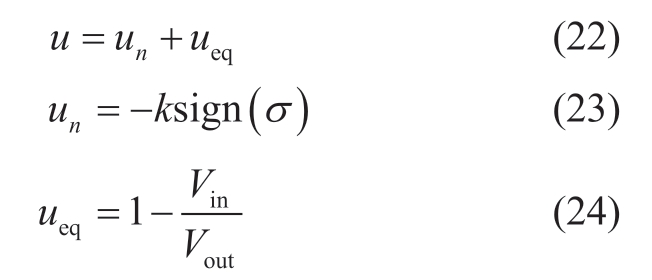
where un represents the switching control,ueq is the equivalent control,k denotes a positive constant,Vin is the input voltage,and Vout is the load voltage [113].
The SM algorithm has a high response speed and shows robustness in a wide range of applications; however,a higher switching frequency may have a negative impact on the energy conversion efficiency and service life of the system.
8 Discussions and conclusions
The exploitation of new sustainable energy sources and the efficiency improvement of existing energy sources are promising research and development directions,among which solar energy and thermoelectric technologies have received widespread attention.Currently,PV and TEG are combined to form hybrid PV-TEG systems to improve the power-generation efficiency of existing PV technologies and efficiently reutilize waste heat [114].It is crucial for hybrid systems to quickly and precisely adjust the operating point to maximize the collected power under changing operating conditions,particularly when multiple LMPPs appear in PSC.Hence,MPPT technologies play an important role in improving the power-conversion efficiency of hybrid renewable energy systems,which can help harvest the maximum output power.Most existing research tends to focus on improving the performance of such hybrid systems in terms of structure and material to enhance their power-generation performance; therefore,in-depth studies on MPPT algorithms are still lacking.Here,14 MPPT algorithms applied to a hybrid PV-TEG system were summarized and classified into five major categories—traditional,mathematics-based,metaheuristics,artificial intelligence,and other algorithms.Figure 18 presents a comparison and evaluation of these five MPPT algorithm types.Notably,these MPPT algorithms do not always operate under standard conditions; however,their performance can be compared with regard to some common aspects,such as the types of PV cells and TEGs,irradiance,other system components,technologies,and dimensions,as summarize in Table 5.
Table 5 Chronological summary of fourteen MPPT algorithms for hybrid PV-TEG systems
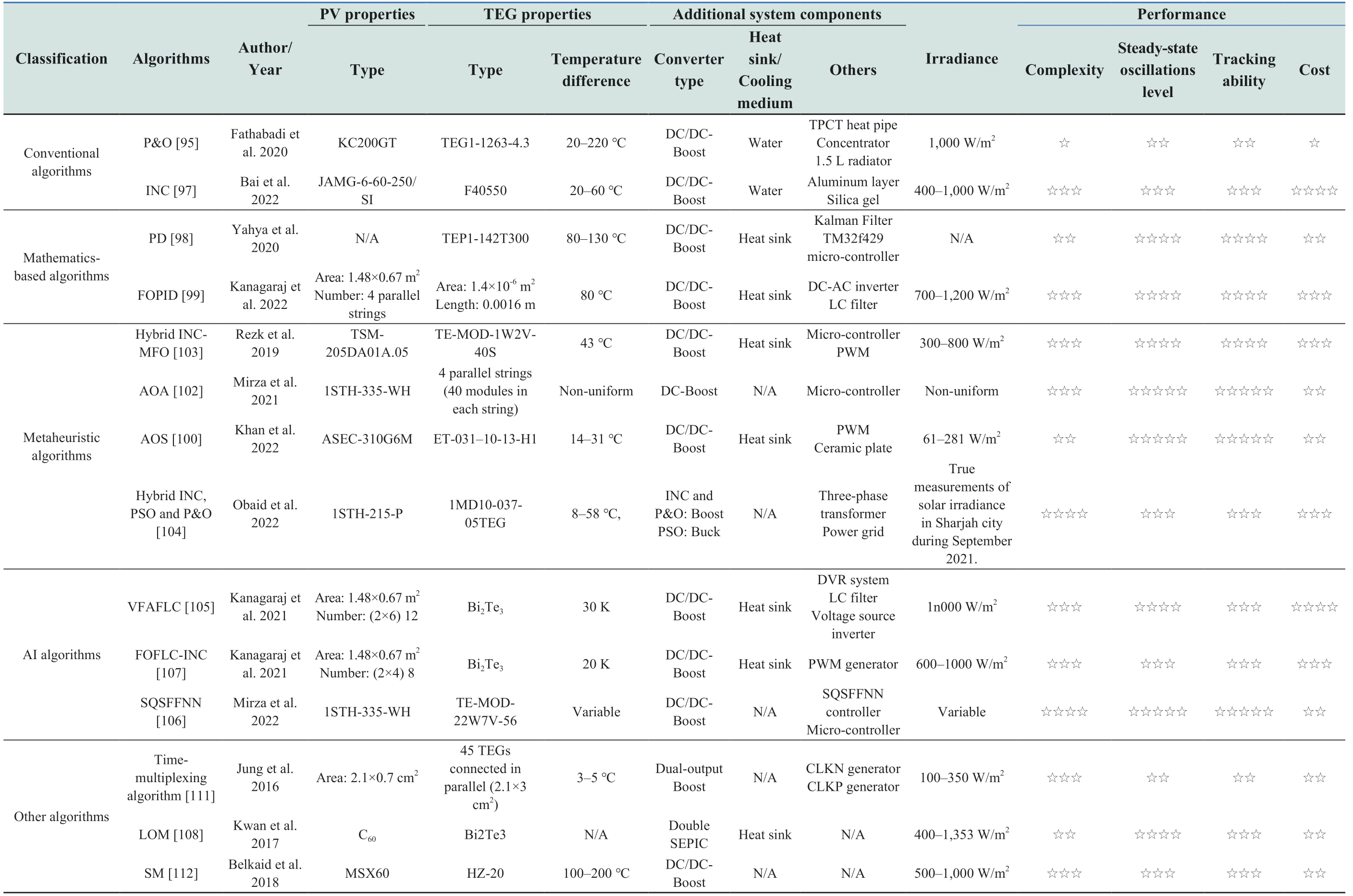
Note.N/A: not applicable.TPCT: two-phase closed thermosiphon.IGBT: insulated gate bipolar transistor.PWM: pulse width modulation.DVR: dynamic voltage restorer.CLKN: negative clock.CLKP:positive clock.☆: very low; ☆☆: low; ☆☆☆: medium; ☆☆☆☆: high; ☆☆☆☆☆: very high.
Based on the current literature,the design of MPPT schemes for application in hybrid systems is still an underdeveloped area with limited research.For instance,previous work [115] has been done to investigate the performance of a hybrid PV-TEG system in an outer space using a non-dominated sorting genetic algorithm (NSGA II) to optimize TEG cooling of the solar panels and provide additional power.This approach could be developed in the future design of MPPT tracking systems to achieve the optimal power output in real time.Other research [116]presented four models describing the operation of the system at and away from the MPP and also used NSGA-II to optimize the models with multiple parameters to optimize performance.Lastly,one study [117] developed a semiinstantaneous numerical code and a tridiagonal matrix algorithm (TDMA) with a central difference scheme discrete implicit formulation was used to handle the governing equations.Here,an (Al2O3/water) nanofluid was selected as the working fluid,and the system exhibited a higher overall energy efficiency.
Fourteen MPPT algorithms applied to hybrid PVTEG systems were developed,categorized,summarized,and compared based on their types of PV and TEG,solar irradiance,complexity,tracking capability,and economics.In doing so,this review provides a systematic discussion of various MPPT algorithms for hybrid PV-TEG systems and aims to offer comprehensive guidance for future research and development.Specifically,the main contributions and recommendations of this review are summarized as follows:
(1) The basic principles of conventional algorithms are relatively well developed and widely used; however,they are prone to LMPPs under uneven irradiance conditions,especially when the operating conditions change abruptly.
(2) Mathematics-based algorithms are capable of achieving MPPT under PSC conditions; however,their convergence speed is relatively low compared to metaheuristic algorithm-based MPPT schemes,and they are relatively complex to design and apply.
(3) Metaheuristic algorithm-based MPPT schemes can effectively and efficiently seek the GMPP under changing operating conditions and show excellent performance in both dynamic response and steady-state output.Furthermore,they are suitable for complex nonlinear systems.However,they suffer from high stochasticity and are vulnerable to algorithm parameter-setting limitations.
(4) The “other” classification of algorithms show desirable robustness and dynamic response,and their structures are relatively simple,meaning they can be easily combined with other converters in practical applications.
9 Perspectives
Future research on MPPT design for hybrid PV-TEG systems can usefully focus on the following four areas:
(1) Currently,most studies have focused on optimizing the structure and improving the optimization efficiency,whereas the diversity of MPPT strategies remains insufficient.The development and design of new MPPT algorithms for hybrid PV-TEG systems is still at its preliminary stages and needs to be enriched and improved.
(2) Hybrid algorithms that combine the merits of different advanced algorithms that can be combined and applied for different purposes is a promising area of research.In addition,the selection of appropriate algorithms for combination and how they can be combined to achieve the desired performance are worthy of further exploration and research.
(3) Hardware experiments should be conducted to further verify the MPPT performance of various algorithms instead of being validated only under simulation or emulation tests.Furthermore,the adoption of different types of PV cells and TEG materials may have an impact on MPPT performance of hybrid systems,and the selection of hardware materials for PV and TEG systems must be considered together with MPPT study to achieve optimal energy conversion and performance.
(4) Research on the electrical connection between the two hybrid PV-TEG systems is currently at the theoretical stage.Therefore,further exploration and verification is needed for practical applications.Suitable electrical connections in combination with MPPT algorithms may be able to achieve better energy conversion efficiencies,and the performance of series-parallel connections can be investigated and compared taking into account the interconnections and interactions between different PV and TEG power-generation modules.Future studies should also consider the safety and reliability of electrical connections in hybrid systems,design suitable protective measures,and monitor mechanisms to ensure the stability of the electrical connections and prevent possible failure or damage.
(5) Hybrid PV-TEG systems may operate under different environmental conditions,such as changing light intensity and temperature,and the rapidly increase in studies on MPPT under dynamic operation conditions highlight the need for research on the guidance/criteria for the selection of specific MPPT algorithms under specific operating situations.Future research could be devoted to developing MPPT algorithms adapted to dynamic environments,to adjust the operating point of the system in real time and maximize energy harvesting and conversion efficiency.
(6) In view of MPPT research on large-scale hybrid PV-TEG systems,it is necessary to solve the challenges of complexity,real-time requirements,tracking accuracy and stability,multi-energy co-management,and system integration.This requires the use of tools including optimization algorithms,control strategies,and big data processing to achieve efficient,reliable,and stable energy conversion and MPPT.
(7) A comparison of the mathematical models of different optimization methods is now required to determine whether there are any differences between them.This will provide a foundation from which the applicability of individual models to different optimization methods can be investigated.
Acknowledgments
This work was supported by National Natural Science Foundation of China (61963020,62263014) and Yunnan Provincial Basic Research Project (202201AT070857).
Declaration of competing interest
The authors declare that they have no competing financial interests or personal relationships that may have influenced the work reported in this study.
References
[1] Bo Yang (2020) Fast atom search optimization based MPPT design of centralized thermoelectric generation system under heterogeneous temperature difference.Journal of Cleaner Production,248: 119301
[1] Kesilmiş Z,Alpaslan Karabacak M,Aksoy M (2020) A novel MPPT method based on inflection voltages.Journal of Cleaner Production,266: 121473
[2] Mansoor M,Mirza A F,Ling Q(2020) Harris hawk optimizationbased MPPT control for PV systems under partial shading conditions.Journal of Cleaner Production,2020,274: 1-19
[3] Subudhi B,Pradhan R (2013) A comparative study on maximum power point tracking techniques for photovoltaic power systems.IEEE Transactions on Sustainable Energy,4(1): 89-98
[4] Singh G K(2013) Solar power generation by PV (photovoltaic)technology: A review.Energy,53: 1-13
[5] Yang B,Liu B Q,Zhou H Y et al.(2022) A critical survey of technologies of large offshore wind farm integration: Summary,advances,and perspectives.Protection and Control of Modern Power Systems,7(1): 1-32
[6] Yang B,Li Y L,Li J L et al.(2022) Comprehensive summary of solid oxide fuel cell control: A state-of-the-art review.Protection and Control of Modern Power Systems,7(1): 1-31
[7] Feroz A,Mirza (2021) High-efficiency swarm intelligent maximum power point tracking control techniques for varying temperature and irradiance.Energy,228: 120602
[8] Makhlouf M,Messai F,Nabti K et al.(2012) Modeling and simulation of grid-connected photovoltaic distributed generation system.2012 First International Conference on Renewable Energies and Vehicular Technology.Nabeul,Tunisia.IEEE,187-193
[9] De Brito M A G,Galotto L,Sampaio L P,et al.(2013) Evaluation of the main MPPT techniques for photovoltaic applications.IEEE transactions on Industrial Electronics,2012,60(3): 1156-1167
[10] Fin M A,Gharapetian D,Asgari M (2022) Efficiency improvement of hybrid PV-TEG system based on an energy,exergy,energy-economic and environmental analysis;experimental,mathematical and numerical approaches.Energy Conversion and Management,265: 115767
[11] Sun D,Shen L,Yao Y,et al.(2017) The real-time study of solar thermoelectric generator.Applied Thermal Engineering,2017,119: 347-359
[12] Jia Y,Alva G,Fang G(2019) Development and applications of photovoltaic-thermal systems: a review.Renewable and Sustainable Energy Reviews,102: 249-265
[13] Verma S,Mohapatra S,Chowdhury S et al.(2021) Cooling techniques of the PV module: A review.Materials Today:Proceedings,38: 253-258
[14] Sahin A Z,Ismaila K G,Yilbas B S et al.(2020) A review on the performance of photovoltaic/thermoelectric hybrid generators.International Journal of Energy Research,44(5): 3365-3394
[15] Elshazly E,El-Rehim A,El-Mahallawi I(2021) Comparison of dust and high-temperature effects on mono and poly photovoltaic panels.In: The 19th International Conference on Aerospace Sciences & Aviation Technology,6-8 April 2021,Cairo,Egypt,pp.1-12
[16] A M,Elbreki (2016) The role of climatic-design-operational parameters on combined PV/T collector performance: A critical review.Renewable and Sustainable Energy Reviews,57: 602-647
[17] Jena S,Kar S K (2020) Employment of solar photovoltaicthermoelectric generator-based hybrid system for efficient operation of hybrid nonconventional distribution generator.International Journal of Energy Research,44(1): 109-127
[18] Champier D(2017) Thermoelectric generators: a review of applications.Energy Conversion and Management,2017,140:167-181
[19] Bandyopadhyay S,Chandrakasan A P (2012) Platform architecture for solar,thermal,and vibration energy combining with MPPT and single inductor.IEEE Journal of Solid-State Circuits,47(9): 2199-2215
[20] Adham,Makki (2015) Advancements in hybrid photovoltaic systems for enhanced solar cells performance.Renewable and Sustainable Energy Reviews,41: 658-684
[21] Siecker J,Kusakana K,Numbi B P(2017) A review of solar photovoltaic systems cooling technologies.Renewable and Sustainable Energy Reviews,79: 192-203
[22] Attivissimo F,Di Nisio A,Lanzolla A M L et al.(2015)Feasibility of a photovoltaic-thermoelectric generator:Performance analysis and simulation results.IEEE Transactions on Instrumentation and Measurement,64(5): 1158-1169
[23] Cai Y,Wang W W,Liu C W,et al.(2020) Performance evaluation of a thermoelectric ventilation system driven by the concentrated photovoltaic thermoelectric generators for green building operations.Renewable Energy,2020,147: 1565-1583
[24] Lin J,Liao T,Lin B(2015) Performance analysis and load matching of a photovoltaic-thermoelectric hybrid system.Energy Conversion and Management,105: 891-899
[25] Wen X,Ji J,Song Z,et al.(2021) Comparison analysis of two different concentrated photovoltaic/thermal-TEG hybrid systems.Energy Conversion and Management,234: 1-17
[26] Singh S,Ibeagwu O I,Lamba R(2018) Thermodynamic evaluation of irreversibility and optimum performance of a concentrated PVTEG cogenerated hybrid system.Solar Energy,170: 896-905
[27] Li G Q,Chen X,Jin Y (2016) Analysis of the primary constraint conditions of an efficient photovoltaic-thermoelectric hybrid system.Energies,10(1): 20
[28] Shatar N S M,Rahman M A A A,Salim S A Z S,et al.(2019)Design of photovoltaic-thermoelectric generator (PV-TEG)hybrid system for precision agriculture.In: 2018 IEEE 7th international conference on power and energy (PECon),Kuala Lumpur,Malaysia,pp: 50-55
[29] Lekbir A,Hassani S,Ab Ghani M R,et al.(2018) Improved energy conversion performance of a novel design of concentrated photovoltaic system combined with thermoelectric generator with advance cooling system.Energy Conversion and Management,177: 19-29
[30] Akbar A,Najafi G,Gorjian S,et al.(2021) Performance enhancement of a hybrid photovoltaic-thermal-thermoelectric(PVT-TE) module using nanofluid-based cooling: indoor experimental tests and multi-objective optimization.Sustainable Energy Technologies and Assessments,46: 1-15
[31] Cheng F Q,Gao Y,Guo X H et al.(2019) Fabrication of nanostructured skutterudite-based thermoelectric module and design of a maximum power point tracking system for the thermoelectric pile.IEEE Sensors Journal,19(14): 5885-5894
[32] Chen T,Guai G H,Gong C,et al.(2012) Thermoelectric Bi2Te3 improved charge collection for high-performance dye-sensitized solar cells.Energy & Environmental Science,5(4): 6294-6298
[33] Chávez-Urbiola E A,Vorobiev Y V,Bulat L P (2012) Solar hybrid systems with thermoelectric generators.Solar Energy,86(1): 369-378
[34] Wu Y Y,Wu S Y,Xiao L(2015) Performance analysis of photovoltaic-thermoelectric hybrid system with and without glass cover.Energy Conversion and Management,93: 151-159
[35] Zhu W,Deng Y,Wang Y,et al.(2016) High-performance photovoltaic-thermoelectric hybrid power generation system with optimized thermal management.Energy,100: 91-101
[36] Rajaee F,Rad M A V,Kasaeian A,et al.(2020) Experimental analysis of a photovoltaic/thermoelectric generator using cobalt oxide nanofluid and phase change material heat sink.Energy Conversion and Management,212: 1-15
[37] Ibrahim M N,Rezk H,Al-Dahifallah M et al.(2019) Hybrid photovoltaic-thermoelectric generator powered synchronous reluctance motor for pumping applications.IEEE Access,7:146979-146988
[38] Bjørk R,Nielsen K K.(2015) The performance of a combined solar photovoltaic (PV) and thermoelectric generator (TEG)system.Solar Energy,120: 187-194
[39] Su S,Liu T,Wang Y,et al.(2014) Performance optimization analyses and parametric design criteria of a dye-sensitized solar cell thermoelectric hybrid device.Applied energy,120: 16-22
[40] Ju X,Wang Z,Flamant G,et al.(2012) Numerical analysis and optimization of a spectrum splitting concentration photovoltaicthermoelectric hybrid system.Solar energy,86(6): 1941-1954
[41] Mohamed M,Mounir S H,Choukairy K,et al.(2018)Performance estimation of the hybridization of crystalline silicon cell with thermoelectric generator.In: 1st International Congress on Solar Energy Research,Technology and Applications(ICSERTA 2018),8-10 May 2018,Ouarzazate,Morocco,pp.1-11
[42] Zhang J,Xuan Y,Yang L(2016) A novel choice for the photovoltaic-thermoelectric hybrid system: the perovskite solar cell.International Journal of Energy Research,40(10): 1400-1409
[43] Motiei P,Yaghoubi M,GoshtasbiRad E.(2019) Transient simulation of a hybrid photovoltaic-thermoelectric system using a phase change material.Sustainable Energy Technologies and Assessments,34: 200-213
[44] Shou C,Luo Z,Wang T,et al.(2012) Investigation of a broadband TiO2/SiO2 optical thin-film filter for hybrid solar power systems.Applied Energy,92: 298-306
[45] Gao Y,Wu D,Dai Z,et al.(2021) Performance analysis of a hybrid photovoltaic-thermoelectric generator system using heat pipe as heat sink for synergistic production of electricity.Energy Conversion and Management,249: 114830
[46] Kohan H R F,Lotfipour F,Eslami M.(2018) Numerical simulation of a photovoltaic thermoelectric hybrid power generation system.Solar Energy,174: 537-548
[47] Mizoshiri M,Mikami M,Ozaki K.(2012) Thermal-photovoltaic hybrid solar generator using thin-film thermoelectric modules.Japanese Journal of Applied Physics,51(6S): 1-5
[48] Sahin A Z,Ismaila K G,Yilbas B S,et al.(2020) A review on the performance of photovoltaic/thermoelectric hybrid generators.International Journal of Energy Research,44(5): 3365-3394
[49] Rezania A,Sera D,Rosendahl L A.(2016) Coupled thermal model of photovoltaic-thermoelectric hybrid panel for sample cities in Europe.Renewable Energy,99: 127-135
[50] Teffah K,Zhang Y(2017) Modeling and experimental research of hybrid PV-thermoelectric system for high concentrated solar energy conversion.Solar energy,157: 10-19
[51] Makki A,Omer S,Su Y,et al.(2016) Numerical investigation of heat pipe-based photovoltaic-thermoelectric generator (HP-PV/TEG) hybrid system.Energy conversion and management,112:274-287
[52] Wen X,Ji J,Song Z.(2021) Performance comparison of two micro-channel heat pipe LFPV/T systems plus thermoelectric generators with and without aerogel glazing.Energy,229: 1-17
[53] Tamaki R,Toyoda T,Tamura Y,et al.(2017) Hybrid photovoltaic and thermoelectric module for high concentration solar system.In: 13th International Conference on Concentrator Photovoltaic Systems (CPV-13),Ottawa,Canada,pp.1-6
[54] Mohsenzadeh M,Shafii M B.(2017) A novel concentrating photovoltaic/thermal solar system combined with thermoelectric module in an integrated design.Renewable Energy,113: 822-834
[55] Li G,Shittu S,Zhao X,et al.(2019) Preliminary experiment on a novel photovoltaic-thermoelectric system in summer.Energy,188: 116041
[56] Zhang H,Yue H,Huang J,et al.(2021) Experimental studies on a low concentrating photovoltaic/thermal (LCPV/T) collector with a thermoelectric generator (TEG) module.Renewable Energy,171: 1026-1040
[57] Wu Y Y,Wu S Y,Xiao L(2015) Performance analysis of photovoltaic-thermoelectric hybrid system with and without glass cover.Energy Conversion and Management,93: 151-159
[58] Huen P,Daoud W A(2017) Advances in hybrid solar photovoltaic and thermoelectric generators.Renewable and Sustainable Energy Reviews,72: 1295-1302
[59] Li G,Shittu S,Diallo T M O,et al.A review of solar photovoltaic-thermoelectric hybrid system for electricity generation.Energy,2018,158: 41-58
[59] Guiqiang,Li (2018) A review of solar photovoltaic-thermoelectric hybrid system for electricity generation.Energy,158: 41-58
[60] Kossyvakis D N,Voutsinas G D,Hristoforou E V (2016)Experimental analysis and performance evaluation of a tandem photovoltaic-thermoelectric hybrid system.Energy Conversion and Management,117: 490-500
[61] Hashim H,Bomphrey J J,Min G(2016) Model for geometry optimisation of thermoelectric devices in a hybrid PV/TE system.Renewable Energy,87: 458-463
[62] Darkwa J,Calautit J,Du D,et al.(2019) A numerical and experimental analysis of an integrated TEG-PCM power enhancement system for photovoltaic cells.Applied Energy,248:688-701
[63] Ismaila K G,Sahin A Z,Yilbas B S (2021) Exergoeconomic optimization of concentrated solar photovoltaic and thermoelectric hybrid generator.Journal of Thermal Analysis and Calorimetry,145(3): 1035-1052
[64] Garud K S,Hwang S G,Han J W et al.(2021) Review on performance enhancement of photovoltaic/thermal-thermoelectric generator systems with nanofluid cooling.Symmetry,14(1): 1-22
[65] Ge Y,Xiao Q,Wang W,et al.(2022) Design of high-performance photovoltaic-thermoelectric hybrid systems using multi-objective genetic algorithm.Renewable Energy,200: 136-145
[66] Gao Y,Dai Z,Wu D,et al.(2022) Transient performance assessment of a hybrid PV-TEG system integrated with PCM under non-uniform radiation conditions: a numerical investigation.Renewable Energy,198: 352-366
[67] Chandan D,Arunachala U C,Varun K (2022) Improved energy conversion of a photovoltaic module-thermoelectric generator hybrid system with different cooling techniques: Indoor and outdoor performance comparison.International Journal of Energy Research,46(7): 9498-9520
[68] Lv S,Yang J,Ren J,et al.(2023) Research and numerical analysis on performance optimization of photovoltaic-thermoelectric system incorporated with phase change materials.Energy,263:1-10
[69] Rezk H,Eltamaly A M(2015) A comprehensive comparison of different MPPT techniques for photovoltaic systems.Solar energy,112: 1-11
[70] Mohapatra A,Nayak B,Saiprakash C (2019) Adaptive perturb& observe MPPT for PV system with experimental validation.2019 IEEE International Conference on Sustainable Energy Technologies and Systems (ICSETS).Bhubaneswar,India.IEEE,257-261
[71] Kalyani C V S L,Kumar M S,Nagaraju T (2020) TEG cascaded solar PV system with enhanced efficiency by using the PSO MPPT boost converter.International Journal of Research in Engineering,Science and Management,3(11): 105-110
[72] Brahmi M,Regaya C B,Hamdi H et al.(2022) Comparative study of P&O and PSO particle swarm optimization MPPT controllers for photovoltaic systems.2022 8th International Conference on Control,Decision and Information Technologies(CoDIT).Istanbul,Turkey.IEEE,1608-1613
[73] Ebrahim M A,Osama A,Kotb K M,et al.(2019) Whale inspired algorithm based MPPT controllers for grid-connected solar photovoltaic system.Energy Procedia,2019,162: 77-86
[74] Li F,Lin D,Yu T,et al.(2021) Adaptive rapid neural optimization: a name="ref75" style="font-size: 1em; text-align: justify; text-indent: 2em; line-height: 1.8em; margin: 0.5em 0em;">[75] Kanagaraj N,Rezk H,Gomaa M R(2020) A variable fractional order fuzzy logic control based MPPT technique for improving energy conversion efficiency of thermoelectric power generator.Energies,13(17): 1-18
[76] Mateo Romero H F,González Rebollo M Á,Cardeñoso-Payo V,et al.(2022) Applications of artificial intelligence to photovoltaic systems: a review.Applied Sciences,12(19): 1-31
[77] Yang B,Zhu T,Wang J,et al.(2020) Comprehensive overview of maximum power point tracking algorithms of PV systems under partial shading condition.Journal of Cleaner Production,268:1-24
[78] Liao T,Lin B,Yang Z.(2014) Performance characteristics of a low concentrated photovoltaic-thermoelectric hybrid power generation device.International Journal of Thermal Sciences,77:158-164
[79] Khan M A I,Khan M I,Kazim A H,et al.(2021) An experimental and comparative performance evaluation of a hybrid photovoltaicthermoelectric system.Frontiers in Energy Research,9: 1-9
[80] Babu C,Ponnambalam P.(2018) The theoretical performance evaluation of hybrid PV-TEG system.Energy Conversion and Management,173: 450-460
[81] Zainal N A,Yusoff A R(2015) Modelling of photovoltaic module using Matlab Simulink.In: 2nd International Manufacturing Engineering Conference and 3rd Asia-Pacific Conference on Manufacturing Systems (iMEC-APCOMS 2015),Kuala Lumpur,Malaysia,pp.1-9
[82] Pillai D S,Rajasekar N.(2018) Metaheuristic algorithms for PV parameter identification: a comprehensive review with an application to threshold setting for fault detection in PV systems.Renewable and Sustainable Energy Reviews,82: 3503-3525
[83] Cotfas P A,Cotfas D T.(2020) Comprehensive review of methods and instruments for photovoltaic-thermoelectric generator hybrid system characterization.Energies,13(22): 1-32
[84] Yang B,Wang J,Zhang X,et al.(2019) MPPT design of centralized thermoelectric generation system using adaptive compass search under non-uniform temperature distribution condition.Energy Conversion and Management,199: 1-14
[85] Mamur H,Coban Y(2020) Detailed modeling of a thermoelectric generator for maximum power point tracking.Turkish Journal of Electrical Engineering and Computer Sciences,28(1): 124-139
[86] Zhang X,Tan T,Yang B,et al.(2020) Greedy search based datadriven algorithm of centralized thermoelectric generation system under non-uniform temperature distribution.Applied Energy,260: 1-15
[87] Lamba R,Kaushik S C(2016) Modeling and performance analysis of a concentrated photovoltaic-thermoelectric hybrid power generation system.Energy Conversion and Management,115: 288-298
[88] Ruzaimi A,Hassan W Z W,Azis N,et al.(2021) Performance analysis of thermoelectric generator implemented on non-uniform heat distribution of photovoltaic module.Energy Reports,7:2379-2387
[89] Ju X,Wang Z,Flamant G,et al.Numerical analysis and optimization of a spectrum splitting concentration photovoltaicthermoelectric hybrid system.Solar Energy,2012,86(6): 1941-1954
[90] Cotfas D T,Cotfas P A,Mahmoudinezhad S,et al.(2022) Critical factors and parameters for hybrid photovoltaic-thermoelectric systems; review.Applied Thermal Engineering,215: 118977
[91] Yang B,Wang J,Zhang X,et al.(2020) Comprehensive overview of meta-heuristic algorithm applications on PV cell parameter identification.Energy Conversion and Management,208: 112595
[92] Yang B,Yu T,Zhang X,et al.(2019) Dynamic leader based collective intelligence for maximum power point tracking of PV systems affected by partial shading condition.Energy Conversion and Management,179: 286-303
[93] Yang B,Zhong L,Zhang X,et al.(2019) Novel bio-inspired memetic salp swarm algorithm and application to MPPT for PV systems considering partial shading condition.Journal of cleaner production,215: 1203-1222
[94] Fathabadi H.(2020) Novel solar-powered photovoltaic/thermoelectric hybrid power source.Renewable Energy,146:426-434
[95] Fathabadi H.(2016) Novel fast dynamic MPPT (maximum power point tracking) technique with the capability of very high accurate power tracking.Energy,94: 466-475
[96] Bai L(2022) Maximum power point tracking control of PV-TE hybrid power generation system in greenhouse.Mathematical Problems in Engineering,2022: 1-9
[97] Yahya K,Alomari O(2021) A new maximum power point tracking algorithm based on power differentials method for thermoelectric generators.International Journal of Energy Research,45(5): 7476-7486
[98] Kanagaraj N,Al-Ansi M(2023) Maximum.Sustainable Energy Technologies and Assessments,53: 102388 extraction control algorithm for hybrid renewable energy system.Computer Systems Science and Engineering,45(1): 769-784
[99] Khan M K,Zafar M H,Mansoor M,et al.(2022) Green energy extraction for sustainable development: A novel MPPT technique for hybrid PV-TEG system.Sustainable Energy Technologies and Assessments,53: 1-20
[100] Azizi M(2021) Atomic orbital search: a novel metaheuristic algorithm.Applied Mathematical Modelling,93: 657-683
[101] Mirza A F,Mansoor M,Zerbakht K,et al.(2021) Highefficiency hybrid PV-TEG system with intelligent control to harvest maximum energy under various non-static operating conditions.Journal of Cleaner Production,320: 1-16
[102] Rezk H,Ali Z M,Abdalla O,et al.(2019) Hybrid moth-flame optimization algorithm and incremental conductance for tracking maximum power of solar PV/thermoelectric system under different conditions.Mathematics,7(10): 1-21
[103] Obaid W,Hamid A K(2022) Grid-connected hybrid solar/thermoelectric power system with hybrid INC/PSO/PO MPPT system in Sharjah,United Arab Emirates.In: 2022 Advances in Science and Engineering Technology International Conferences(ASET),Dubai,United Arab Emirates,pp.1-5
[104] Kanagaraj N,Rezk H(2021) Dynamic voltage restorer integrated with photovoltaic-thermoelectric generator for voltage disturbances compensation and energy saving in three-phase system.Sustainability,13(6): 1-31
[105] Mirza A F,Szczepankowski P,Luszcz J(2022) Cleaner energy for sustainable future using hybrid photovoltaics-thermoelectric generators system under non-static conditions using machine learning based control technique.Sustainable Energy Technologies and Assessments,53: 1-17
[106] Kanagaraj N(2021) Photovoltaic and thermoelectric generator combined hybrid energy system with an enhanced maximum power point tracking technique for higher energy conversion efficiency.Sustainability,13(6): 1-21
[107] Kwan T H,Wu X(2017) The Lock-On Mechanism MPPT algorithm as applied to the hybrid photovoltaic cell and thermoelectric generator system.Applied Energy,204: 873-886
[108] Kwan T H,Wu X(2017) TEG maximum power point tracking using an adaptive duty cycle scaling algorithm.Energy Procedia,2017,105: 14-27
[109] Kwan T H,Wu X(2017) High performance P&O based lock-on mechanism MPPT algorithm with smooth tracking.Solar Energy,155: 816-828
[110] Jung D H,Kim K,Jung S O(2016) Thermal and solar energy harvesting boost converter with time-multiplexing MPPT algorithm.IEICE Electronics Express,13(12): 20160287
[111]Belkaid A,Colak I,Kayisli K et al.(2019) Maximum power extraction from a photovoltaic panel and a thermoelectric generator constituting a hybrid electrical generation system.2018 International Conference on Smart Grid (icSmartGrid).Nagasaki,Japan.IEEE,276-282[112] Benhadouga S,Belkaid A,Colak I,et al.(2021) Experimental validation of the sliding mode controller to improve the efficiency of the MPPT solar system.2021 10th International Conference on Renewable Energy Research and Application (ICRERA).Istanbul,Turkey.IEEE,333-337
[113] Yang B,Wu S C,Huang J X,et al.(2023) Salp swarm optimization algorithm based MPPT design for PV-TEG hybrid system under partial shading conditions.Energy Conversion and Management,292: 1-27
[114] Kwan T H,Wu X(2016) Power and mass optimization of the hybrid solar panel and thermoelectric generators.Applied Energy,165: 297-307
[115] Yusuf A,Bayhan N,Tiryaki H,et al.(2021) Multi-objective optimization of concentrated Photovoltaic-Thermoelectric hybrid system via non-dominated sorting genetic algorithm (NSGA II).Energy Conversion and Management,236: 1-14
[116] Kolahan A,Maadi S R,Kazemian A,et al.(2020) Semi-3D transient simulation of a nanofluid-base photovoltaic thermal system integrated with a thermoelectric generator.Energy Conversion and Management,220: 1-16
Received: 8 June 2023/ Accepted: 3 August 2023/ Published: 25 October 2023
✉Jingbo Wang
JingboWang96@outlook.com.
Bo Yang
yangbo_ac@outlook.com
Rui Xie
2511146029@qq.com
Jinhang Duan
2972092338@qq.com
2096-5117/© 2023 Global Energy Interconnection Development and Cooperation Organization.Production and hosting by Elsevier B.V.on behalf of KeAi Communications Co.,Ltd.This is an open access article under the CC BY-NC-ND license (http: //creativecommons.org/licenses/by-nc-nd/4.0/).
Biographies

Bo Yang is a professor and Ph.D.supervisor in the School of Electric Power Engineering,Kunming University of Science and Technology,and received his Ph.D.degree from the University of Liverpool,UK,in 2015.He has published more than 150 SCI journal papers and 30 EI journal papers.His research interests include smart grid and the optimization and control of new energy systems based on artificial intelligence.

Rui Xie received her B.E.degree from Kunming University of Science and Technology in 2022 and is currently pursuing a master’s degree in power systems and their automation in the School of Electric Power Engineering,Kunming University of Science and Technology.Her research interests include maximum power point tracking of hybrid PVTEG systems and economic dispatch.

Jinhang Duan received her B.E.degree from Kunming University of Science and Technology in 2022 and is currently pursuing a master’s degree in electrical engineering in the School of Electric Power Engineering,Kunming University of Science and Technology.Her research interests include wave energy converter array layout optimization and economic dispatch.

Jingbo Wang received his master’s degree from Kunming University of Science and Technology in 2022,and was awarded a full scholarship by China Scholarship Council(CSC) to study for a doctoral degree at the University of Liverpool,UK,in 2022.His research interests include modeling and optimization of new energy generation systems.Corresponding author.
(Editor Dawei Wang)
